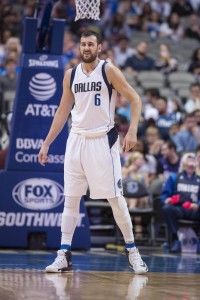The one-year, $2.3MM contract Andrew Bogut signed with the Lakers is only guaranteed for $50K, tweets Bobby Marks of ESPN. Bogut and his agent spent the summer trying to convince teams there would be no lingering effects from the broken left tibia he suffered in March while with the Cavaliers. Other organizations expressed interest, but Bogut opted for the Lakers, even though the guarantee is extremely low for a veteran of his caliber.
The 32-year-old center was plagued by injuries last year, well before the mishap in Cleveland. Knee and hamstring issues limited him to just 26 games in Dallas before he was shipped to Philadelphia at the February trade deadline. Bogut’s agent, David Bauman, said last week that a CT scan showed a “complete healing” of the break. If that means Bogut can contribute the way he did in Golden State, the Lakers may have nabbed a major bargain.
There’s more today out of Los Angeles:
- GM Rob Pelinka said Bogut was signed because the team needs a defensive presence in the middle, tweets Serena Winters of LakersNation.com. Pelinka said the Lakers were among the worst teams in the league last season at stopping opponents at the rim, and he sees Bogut as a “paint protector.” Coach Luke Walton, who talked to Bogut on the phone before the signing, is excited about what he can bring. “It was a very honest conversation about where he’s at and where we’re at and what possible minutes would be at,” Walton explained, “and I said I would obviously love to have you, you can anchor our defense, the way you can pass the ball, the fact that you are a champion around our young players is something that can be huge for us.”
- The addition of Lonzo Ball should transform a team that was in the bottom five last season in assist percentage, writes Paolo Uggetti of The Ringer. Observers raved about Ball’s passing and court vision as the Lakers captured the Las Vegas Summer League title, and Uggetti thinks those skills will be even more evident with veteran teammates. However, he expects L.A. to keep struggling on defense, although the signing of Kentavious Caldwell-Pope will help on the perimeter, and believes another 50-loss season might lie ahead.
- After a summer filled with roster upheaval, Ball and Brandon Ingram are the only players certain to be long-term Lakers, according to Zach Buckley of Bleacher Report.
